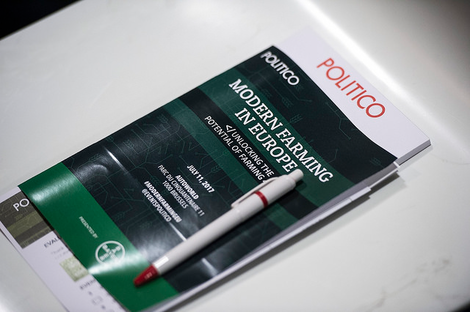On 11 July 2017, Politico invited the Commission's Vice-President for Jobs and Growth, Jyrki Katainen, to outline the institution's vision for the EU budget and the next CAP. Just like any other item on the agenda, Europe's agricultural budget will not be exempt from slimming, meaning that the CAP will have to do more with less. By increasing farm holdings' profitability and streamlining the monitoring of the CAP, including compliance requirements, smart farming can help stomach the budget gap. But the uptake on the ground is lagging behind.
Following Mr. Katainen's speech, representatives from the agri-food sector screened the role of different EU funding schemes in removing the barriers for the uptake of smart farming in Europe, with access to broadband and cost-benefit assessments of already existing technologies identified as the most pressing challenges.
Curbing zoonotic diseases with ICT-enabled farming
The discussion started with an emphasis on ICT-enabled farming as a contributor to health safety. With cattle herds expected to get bigger to catch up with the global demand for meat, farmers will find it more difficult to monitor the health of their animals. Applications such as real-time sound and image analysis make it possible to spot sick animals at an early stage in the development of a disease.
To what extent are smart farming products worth their price? The EU shall answer that question
Programme officer Joel Bacquet reminded that the barriers for the uptake of precision farming did not only lie in the cost of the technologies, but also in the uncertainty when it comes to value for money. This is where innovation projects such as IoF2020 come into play. By telling the difference between what is working and what is not along its 19 use-cases covering the whole food chain in arable, vegetables, fruits, meat and dairy farming, the project will allow farmers to make better-informed decision in finding the right technologies for them and apply them in the most efficient way possible.
Broadband roll-out in remote areas: what should be done and by whom?
The penetration rate of smart farming is a function of how fast broadband internet access spreads across rural areas in Europe. Fast broadband roll-out, like most infrastructure work, remains a national prerogative. Panelists nonetheless stressed the potential of the European Regional Development Fund (ERDF) and the Second Pillar of the CAP in nudging public authorities and telecommunication market operators into investing in internet-access-related infrastructure development, including superfast broadband and 5G. As for the 204-2020 MFF, the Rural Development Pillar of the CAP allows regional authorities to co-fund projects aimed at creating, expanding or improving broadband infrastructure in remote areas.
VP Jirki Katainen: "Digitisation is the new EU infrastructure frontier"
In addition, Jyrki Katainen stressed the role of the European Fund for Strategic Investment (EFSI) in unlocking private investments in telecommunication infrastructures through guarantee for debt investments and equity funds. Set up as the first Pillar of the Juncker Plan, the €21 billion EFSI is increasingly earmarked for supporting high-speed digital networks in Europe, in a context where the Digital Single Market has replaced the Energy Union as the lead investment priority for the continent.